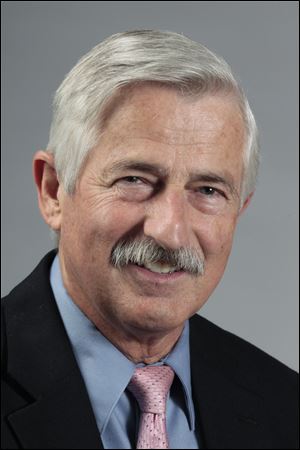
COMMENTARY
Toledo’s newest museum is as great as the Lakes
5/5/2014
Walton
You don't have to be a sailor or a fisherman to appreciate what the Great Lakes mean to the middle of America — economically, recreationally, historically, even emotionally.
But as someone who once worked on the lakes, I’ve never for a moment doubted their importance. Somebody else who gets it is Paul LaMarre, the man whose sketch on a restaurant napkin seven years ago started a journey that has delivered Toledo’s coolest new attraction: the National Museum of the Great Lakes on the east bank of the Maumee River.
That’s how great ideas are often hatched. J.K. Rowling jotted down her early ideas for Harry Potter on a napkin on a British train. Seattle’s iconic Space Needle was allegedly conceived on a napkin in a coffee house in 1959.
Mr. LaMarre, now director of the Port of Monroe, was out for dinner with his wife in 2007 when he began sketching on a napkin his vision of how best to use the-then S.S. Willis B. Boyer museum ship and the new ferry terminal in the Marina District. He tinkered with the drawing the next day, and that version now hangs in the museum.
Toledo’s newest jewel, which opened nine days ago, has operated for decades in Vermilion, 80 miles to the east, but in far smaller quarters and with far less fanfare. Traveling by car from Vermilion to Toledo takes less than two hours, but there were surely times over the past seven years when it seemed as if this project were on a slow boat to China.
Slow doesn’t come easily for Mr. LaMarre, who once flew jets in the Navy.
“There were frustrations,” he says. In the early days, he was pretty much flying solo. Eventually the City of Toledo, the Toledo-Lucas County Port Authority, and the community rallied to the cause. And a magical moment arrived.
“The only time I wept on this project,” he said, was when the ship floated away from its old dock near the Anthony Wayne Bridge and headed toward its new home at the museum.
The Boyer has been rechristened with its original name, the Col. James M. Schoonmaker. Christopher Gillcrist, the executive director of the museum, calls the ship “perhaps the best restored museum ship in the nation.” He’ll get no argument from me.
So vast is the museum’s collection, barely half of it is displayed. Part of that is a consequence of the building’s size. It was built as a passenger ferry terminal, not a museum. The hope is that passenger ships will one day come calling.
If wishing and unlimited funds were all it took, the place would be bigger. But it is a perfect size for its mission, which includes a major educational component.
Schoolkids are going to love it. They’ll learn the history of the Great Lakes the fun way — hands on — with more than 40 exhibits that involve some form of audience participation.
This is not your grandfather’s museum. It’s not a collection of old stuff sitting in display cases or behind windows.
It’s also plenty big enough to permit the display of items that could not be shown in Vermilion, including the propeller from the freighter John Sherwin. The propeller, which is 22 feet from blade tip to blade tip and weighs 20 tons, was cast in Toledo in the 1950s.
One of the museum’s sections deals with Great Lakes shipwrecks. The centerpiece of the exhibit is an inflatable life raft that broke loose from the Edmund Fitzgerald when it sank in Lake Superior in 1975.
It’s a raft I remember well — it sat just above my quarters when I served as a Fitzgerald crew member in 1963. Museum visitors can even steer a simulated submersible through and around a computer-generated version of the wreckage of the Fitz.
Elsewhere they learn about the Wyandotte, the first lake freighter that could unload itself. They can operate a hand-powered bilge pump and discover what it took to keep a ship afloat.
The museum is by definition Toledo’s newest tourist attraction. Let’s hope the tourists show up by the thousands, including from distant points. Americans, no matter where they live, need to understand what we Midwesterners already know about this marvelous natural resource.
Yes, the Great Lakes have issues. The algae blooms that discolor Lake Erie’s western end are scary and embarrassing. So is the potential for ecological disaster at Facility Three, the man-made landfill in Maumee Bay.
However, and I hope you’ll excuse the bad metaphor, I see the Great Lakes not half empty, but half full. The lakes hold 84 percent of the continent’s fresh water. And all of it, as the promotional items in the museum’s gift shop point out, is “unsalted and shark free.”
Thomas Walton is the retired editor and vice president of The Blade. His column appears every other Monday. His commentary, “Life As We Know It,” can be heard each Monday at 5:44 p.m. on WGTE-FM 91.
Contact him at: twalton@theblade.com